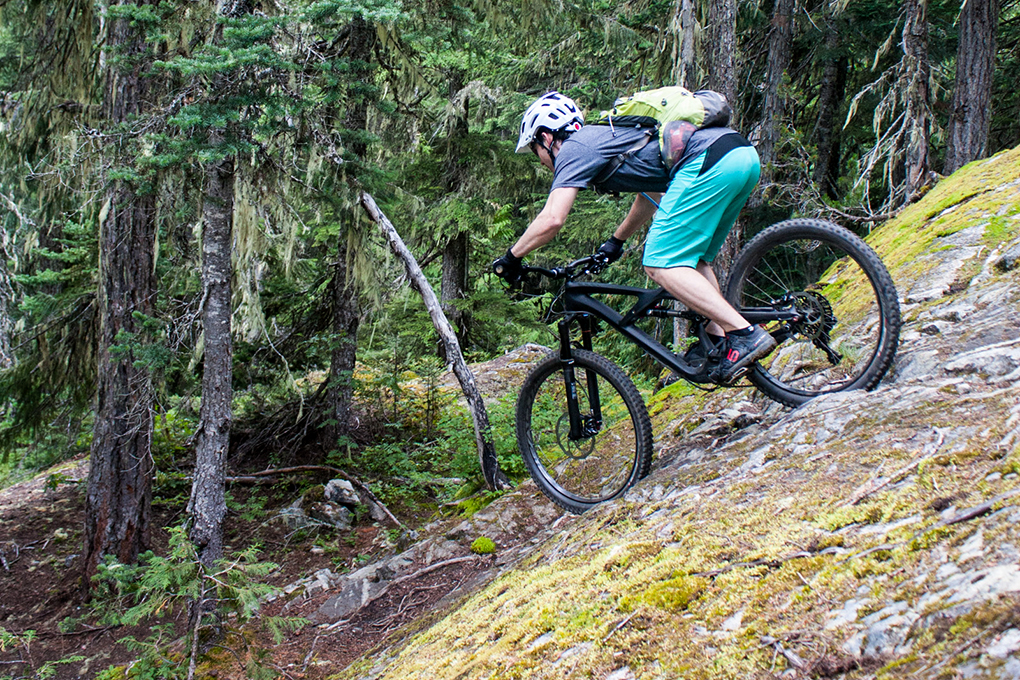
FLY Racing Freestone Helmet
MSRP: $110
Size: M/L (55-59cm)
Blister’s Measured Weight: 364 grams
Features:
- ConeHead™ Technology – the name for a new way to mold EPS foam for helmets. The new ConeHead™ acts like a crumple zone around the head to absorb and dissipate impact forces more effectively than current hard foam liners. There are two different densities of foam as well as two different foams with their own characteristics of recovery from impact and inter-foam bond strength.
- 328-362g on helmet label, 317.5g (on website) for a Med/Large helmet
- Safety compliance: EN1078-1997 +A1-2005 standards
Reviewer’s Head Size: 59cm
Days Tested: 9
Locations Tested: Whistler, BC; Park City, UT
The Freestone helmet is FLY Racing’s entry into the competitive world (and growing segment) of trail helmets.
Generally, trail helmets offer a bit more coverage than a standard XC lid, particularly down the back of the head. That’s a good thing, since they are often being worn on rowdier technical trails. The downside is that these helmets often end up being a bit hotter than an XC lid because of the increased coverage.
We decided to test the Fly Racing Freestone because we are always on the lookout for good values.
While there are some great high-end offerings out there as well as some pretty inexpensive options, for the most part, fully featured helmets run $130 – $200. For a piece of protection that is supposed to be retired after a crash, that’s a lot of dough.
The FLY Freestone moves in the right direction, coming in at $110 while offering all the features of more expensive helmets.
Safety
As we’ve said in all our helmet reviews, we aren’t able to provide you with any quantifications of protection other than the standards this helmet meets. FLY lists compliance with the CEN (European) standard on their website and compliance with the CPSC standard on a label inside the helmet. FLY Racing also describes a new technology they are using – ConeHeadtm Technology (see “Features”) – It sounds like a great idea, but without any quantification it is impossible to know if it increases impact protection or not. We’ll keep saying this: Helmet Manufacturers, we would really like to see data.
Details
The Freestone comes across as a well-built helmet.
The ear straps are each individually fixed into the edge of the helmet instead of being connected at the back and running around the back of the head through a plastic clip.
This is a nice touch that makes getting proper strap adjustment a bit easier, and improves comfort by keeping the straps out from behind the head.

The visor on the Freestone is on the longer side and stays in place, anchored with moto-style attachment—a screw on each side and a screw and slot in the middle used to adjust visor angle and then lock it in place.
I really like longer visors because they provide better shade from the sun (which is especially useful when you are riding into the sun) and they provide more protection from stray branches. I give the Freestone good marks for its visor.
Ventilation in this helmet is quite good. Channeling and exit vents are critical to getting air to flow through a helmet, and the vents in the Freestone are large, and the interior channeling is plentiful. When you are moving along at a steady pace, air is forced into the front of the helmet pretty easily, but it needs to be able to flow through in order to provide effective cooling. Good channeling is critical and the Freestone does that well.
The ratchet dial in the back makes size adjustments easy, and the range of adjustment for the helmet is quite good.
On Trail
The Freestone helmet is comparable in weight to a TLD A1, but it feels a bit lighter on the trail. Again, I was quite pleased with the ventilation, and the Freestone is one of the cooler helmets I’ve worn recently. The front vents are covered with mesh panels that keep bugs out, but do make it impossible to store sunglasses in the vents (you could always cut them out, though).

The medium-density foam pads on the side of the helmet helped create a snug fit and made the helmet feel lighter than it is.
However, the rear strap on the retention system is wide, flat, didn’t conform well to my head, and made the helmet feel just a bit boxy. Additionally, the size M/L seemed a little big for my 59cm head, and required the retention system to be tightened quite a bit. This surprised me, because I’m on the uppermost end of the recommended sizes.
Comparisons
Troy Lee Designs A1 – The Freestone is a bit cooler, but not quite as comfortable. The A1 has some of the thickest padding I’ve found on a half-shell helmet. Paired with a great shell fit, the A1 feels like it was made for my head and that seems to be common feedback among other riders.
Giro Xar – The Xar is a bit cooler, but does not feel like it offers quite as much coverage. The fit of the shell on the Giro is a bit better for my head, but it doesn’t offer the enveloping feel of the FLY helmet.
Bottom Line
The FLY Freestone is a good, high-coverage trail helmet at a great price. It provides good ventilation despite the increased coverage, and offers a slightly different look than the bigger brands.
Some folks might find the fit to feel unnatural, though, with the wide, flat and low retention system, so make sure to try this one on before you buy it.
